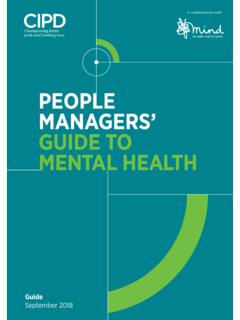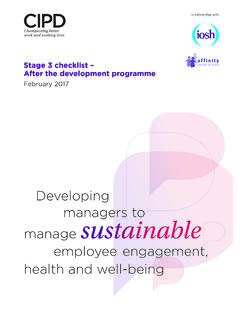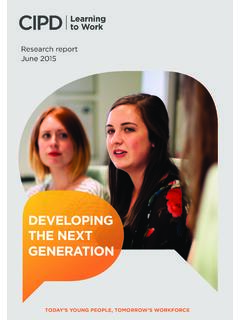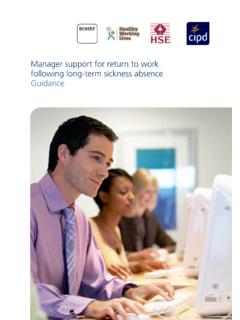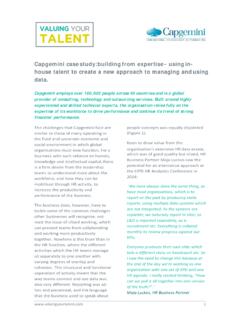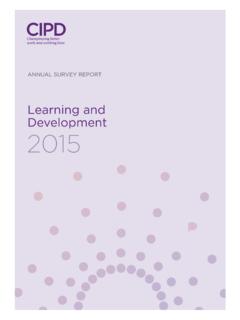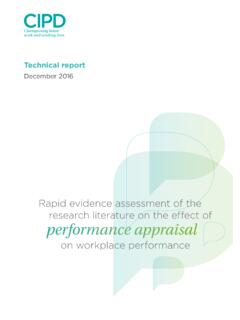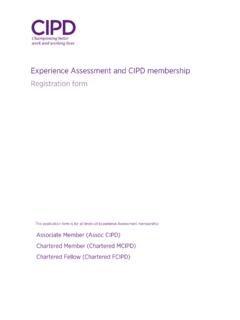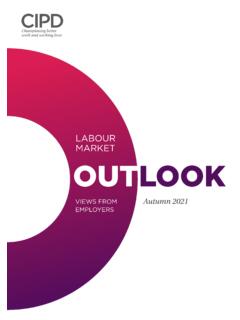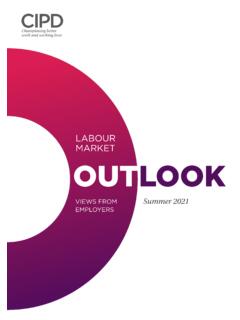Transcription of managers to sustainable - CIPD
1 Developing managers to manage sustainable employee engagement, health and well-beingResearch report phase 2 February 2017in partnership with1 Developing managers to manage sustainable employee engagement, health and well-beingThe CIPD is the professional body for HR and people development. The not-for-profit organisation champions better work and working lives and has been setting the benchmark for excellence in people and organisation development for more than 100 years. It has more than 140,000 members across the world, provides thought leadership through independent research on the world of work, and offers professional training and accreditation for those working in HR and learning and Developing managers to manage sustainable employee engagement, health and well-beingIntroduction 21 Research aims and methodology 62 Results 8 Revising the checklists 8 Maturity model: a diagnostic tool 123 Organisational case studies 14 Top tips 23 How to use these resources in your organisation 24 Summary and conclusions 25 References 27 Appendix 1.
2 Flow chart of research process of previous research project 29 Appendix 2: Checklists 30 Further resources and sources of information 52 Developing managers to manage sustainable employee engagement, health and well-beingResearch report phase 2 This research report was written by Rachel Lewis, Emma Donaldson-Feilder and Kate Godfree of Affinity Health at Work (Rachel Lewis is also an Associate Professor at Kingston Business School). Affinity Health at Work is a specialist consultancy offering research and consultancy solutions to improve workplace health, well-being and engagement. For further details about the research project or Affinity Health at Work, please contact Rachel Lewis, or Emma Donaldson-Feilder, or visit Health at Work are most grateful for the support from the members of their research consortium and from all the participating organisations who were involved in the project.
3 AcknowledgementsContents2 Developing managers to manage sustainable employee engagement, health and well-being3 Developing managers to manage sustainable employee engagement, health and well-beingIntroductionBackground to the researchAcademic and practitioner evidence demonstrates that employee health, well-being and engagement are important for organisational success. For example, in a meta-analysis, Ford et al (2011) found links between employee psychological health and well-being and overall performance; Donald et al (2005) found that almost a quarter of the variance in employee productivity is explained by psychological well-being, perceived commitment of the organisation to the employee and resources and communication.
4 A positive relationship has also been shown between employee engagement and organisational performance; for instance, a Gallup study (2010) found that business units with the highest engagement scores (the top 25%) averaged 18% higher productivity than those with the lowest engagement scores (the bottom 25%). While employee health, well-being and engagement each play a significant role in performance, Lewis et al (2012) proposed that it is the combination of employee engagement, health and well-being that enables sustainable positive outcomes over a prolonged period. Robertson et al (2012) found evidence for the positive outcome of this interaction such that a combination of engagement and psychological well-being predicted productivity levels better than engagement alone.
5 A Towers Watson study (Fairhurst and O Connor 2010) highlighted the negative interaction, suggesting that highly engaged employees whose well-being is not protected are at risk of burnout and, ultimately, reduced engagement and performance. The same study also found that if organisations are investing in employee engagement activities but not also acknowledging health and well-being, there is a risk of only a short-term impact on engagement. Literature has also shown that how employees are managed is vital to their health and well-being (Kelloway and Barling 2010). To examine which particular manager behaviours are key to employee health and well-being, the authors and colleagues (Yarker et al 2007, Yarker et al 2008, Donaldson-Feilder et al 2009, Donaldson-Feilder and Lewis 2011) conducted a four-phase research programme which examined the particular behaviours managers need to adopt in order to prevent and reduce stress in their behaviour not only impacts on employee health and well-being, but also on employee engagement, as demonstrated in both academic and practitioner research.
6 For example, in the CIPD s Shaping the Future project, managers were highlighted as one of the most important influences on engagement (CIPD 2011). The academic literature also includes a consistent body of research which demonstrates the link between employee engagement and various leadership approaches, such as leader member exchange (Breevart et al 2015), transformational leadership (Tims et al 2011), authentic leadership (Bamford et al 2013) and supportive leadership (Thomas and Xu 2011). Lewis et al (2011) identified specific management behaviours important for employee engagement. Manager behaviour not only impacts on employee health and well-being, but also on employee engagement, as demonstrated in both academic and practitioner research.
7 2 Developing managers to manage sustainable employee engagement, health and well-being3 Developing managers to manage sustainable employee engagement, health and well-beingGiven that research suggests that the combined impact of engagement and health and well-being may be greater than each one alone (see above, and also Robertson and Birch 2010), in order to attain sustainable performance outcomes it is critical to create high levels of both employee engagement and employee health and well-being. Given that manager behaviour is an important determinant of both engagement and health and well-being, it is important to understand which specific behaviours simultaneously protect/enhance employee well-being and engender employee engagement.
8 To achieve this understanding, Lewis et al s (2012) Managing for sustainable Engagement research combined the two frameworks management competencies for preventing and reducing stress and management competencies for enhancing employee engagement to develop a management behaviour framework that sets out how managers can manage for sustainable employee engagement, that is, both engagement and health and well-being. This research identified five management competencies key for protecting and promoting the engagement and well-being of employees. These include: open, fair and consistent: managing with integrity and consistency, managing emotions/personal issues and taking a positive approach in interpersonal conflicts handling conflicts and problems: dealing with employee conflicts (including bullying and abuse) and using appropriate organisational resources knowledge, clarity and guidance: clear communication, advice and guidance, demonstrates understanding of roles and responsible decision-making building and sustaining relationships: personal interaction with employees involving empathy and consideration supporting development.
9 Supporting and arranging employee career progression and the management behaviours important for engendering employee engagement and well-being are identified, the challenge becomes one of supporting managers to develop and use these behaviours in their team interactions. The question is how to undertake effective management development and ensure that the skills managers develop are applied in the workplace. It is this critical question that our research has tackled. To summarise, both academic and practitioner literature are clear on two points: first, that employee engagement, health and well-being are key for the productivity, performance and success of organisations; and second, that the way that employees are managed is a vital determinant of their engagement, health and well-being.
10 This means that managers need to be equipped with the skills and behaviours both to engage, and to protect the health and well-being of, their teams. To achieve this, organisations need to provide the most effective management development possible. Figure 1: The importance of developing managers for sustainable employee engagement, health and well-being, and ultimately performanceOrganisation performanceManagement competencies and behavioursEmployee engagementEmployee well-being4 Developing managers to manage sustainable employee engagement, health and well-being5 Developing managers to manage sustainable employee engagement, health and well-beingWhat does the current body of management development research tell us?
